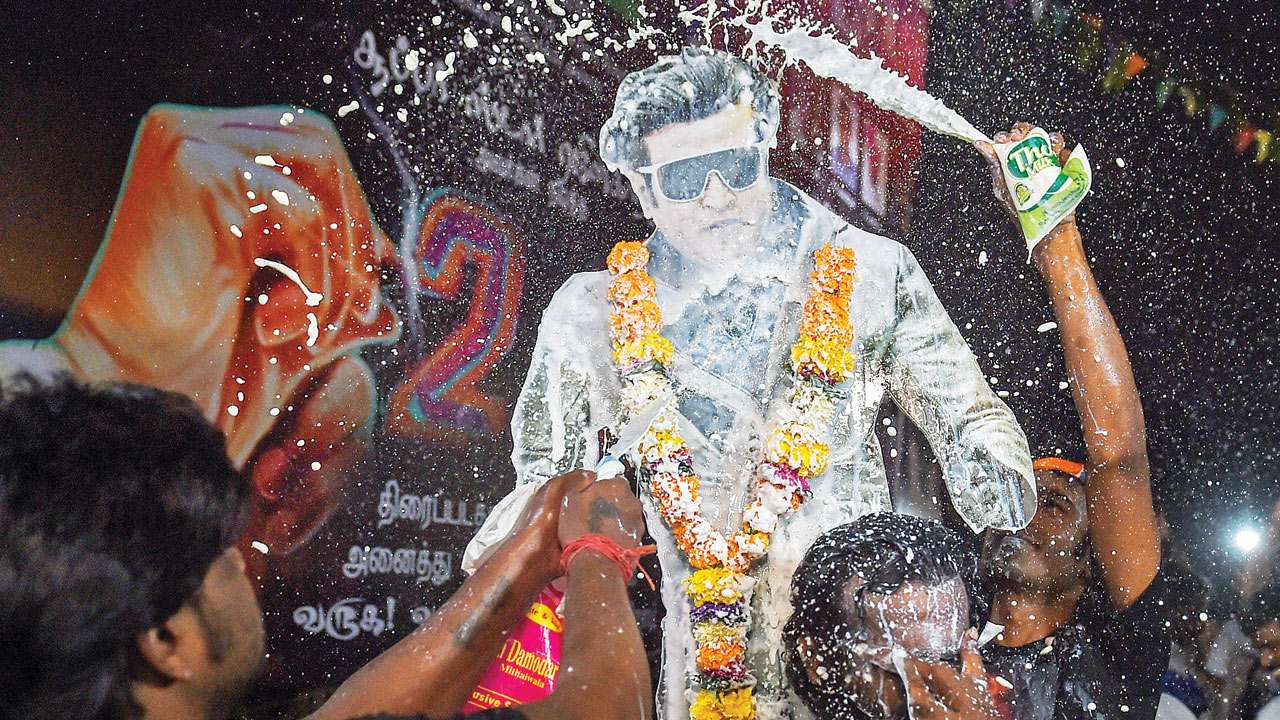Jwalika Balaji, Trainee Film-Critic, (Batch of 2023) writes for our fortnightly movie review column.
*For all those who have heard of 2.0, the latest Rajni blockbuster directed by Shankar, (and those who haven’t, you poor peasants), here’s a break-down of the movie. This review shouldn’t stop you in any way from watching it, because, hello, if you don’t watch the newest Rajni movie, what are you doing with your lives? Get your Rajni on!*
2.0 has all the components of your quintessential Shankar movie:
- A mega star (The Superstar, in this case).
Rajnikanth is not just a star, he is a phenomenon in South India. If the fame, respect, adoration, love, and devotion (yes, you don’t just buy tickets for a Rajni movie, you purchase tickets for a darshan of the Lord Himself) that Rajni enjoys could be quantified into a statue, it would loom large over the new 3000 crore statue. And I’m sure that more people would identify Rajni quicker than they did Patel, but wait, what, I didn’t say anything, I mean, I like saffron and splurging on oh-so-useful statues. Long live cows!
- A heroine who is young enough to be the mega star’s grand-daughter.
Usually, the heroine would be trained in a modicum of acting or at least have two types of expressions on her face that could be classified as ‘happy’ and ‘sad’ and some are skilled to the extent that they can put on a lovey-dovey face (which usually makes it seem like they are suffering from constipation, but hey, it’s what the masses want – a love-struck expression, not constipation – and you gotta play to the gallery.) Amy Jackson has reached new lows in this movie. She has received her training from the school of minimalist acting (read: a school that teaches one to how to look like a human yet still have the expressions of a dead tree on one’s face). That’s why this role must have been Amy’s dream role. It’s a match made in heaven. Even the SBA’s cent-per-cent accurate mentor-mentee matchup algorithm couldn’t have made a better match. She plays the role of a robot. But the catch is that she’s still a robot modelled after an Indian woman and as a stereotypical Indian woman must be, when asked what her interests are, she replies that they revolve around movies, TV serials and make-up. Yes, here we finally have a woman robot who kicks ass but who still succumbs to the Vani-Ranis and the Naaginis of the day. Talk about having the best of both worlds (Yes, honey, I’ll go to work but don’t worry, I’ll cook and wash the clothes and take care of the kids and do all the household jobs as well.) We must all strive to be this perfect Indian woman. Thanks, Amy, for showing us the way.
- Gravity-defying fight scenes that are so fantastical that they make this grand-daughter typed heroine fall in love with the mega star.
And to add to those, the 3D effects are great. Both the five-year kid sitting next to me and I were shrieking in excitement when the bullets came zooming towards us because of the 3D effects. The kid’s mom gave me the dirtiest look ever and internally I was like, ‘I’m in Law School and that’s the only thing throwing itself at me at the moment. I’m going to take it.’ I don’t think she sympathized with me though or maybe she read my mind or something, for she made her kid switch seats, taking it away from anything that is associated with Law School (yes, her problem is with Law School, not with me, or so I like to think). I feel like this is what my mother also should’ve done when the topic of Law School first came up – warned me to run away as far as I could have.
- A bad, bad villain and revenge by the mega star.
The villain has a senti life story, which could have the potential to make the movie greyer and introduce some ethical turpitude in the mind of the hero and the audience, but is always painted over by loud shades of black, to justify the hero killing the villain in the end. This is especially prominent in a Shankar film, as opposed to films by other renowned Tamil directors. Especially after just having had my idea of objectivity and truth thrown out the window, this aspect seems problematic as it ends up othering the villain. (As all first years hopefully know by now, ‘It is only within a standpoint that privileges objectivity and absolutes that relativism and pluralism present a problem’.) Suck it, Shankar. It’s time for you to attend a History course at Law School.
- Three hours of a tussle between the bad, bad villain and the mega star completely devoid of logic.
The director assumes that the audience leave their brains at home, (which they do, I mean, it is a Shankar film.) There was a bit of mambo-jambo in 2.0 where the aura of dead sparrows and a dead man merge into some gigantic eagle-type avatar protected by cell phones. This avatar has the power to enter the bodies of other human beings which makes it hard to kill the said human beings, for, don’t kill the messengers, right? There is a very funny scene in 2.0 which is very Anniyan-like, with a split personality. To all you North-Indian non-South-Indian-movie-watchers-because-it-is-beneath-your-dignity (Hmm, I wonder what sort of an effect a History I course is having on me), think of the scene in Chennai Express where Deepika unleashes her dual personality: ‘Thangabaleee, kitta varadhe, nan jora odhipen da// nan unna vida matten// kitta varadhe’ (Thangabalee, don’t come close, I will harm you// I won’t let you go// Don’t come close). Now that I think about it, maybe this dialogue from the perspective of 2.0 is a warning to the audience: “Don’t come close. I will harm you and damage your brain cells with my mind-numbing levels of stupidity.” See, to all the Chennai Express haters out there, there’s so much of depth and this totally justifies my watching that film 15 times.
While these are the components of a generic Shankar film, I found that in this movie, there was another meta component altogether.
- Feminism.
While a pretty woman (a normal, pretty woman, not the hooker, Good Lord, abishtu, abishtu) is the only thing related to women in most of Shankar’s films, I was able to unearth a very deep analogy (that he might or might not have intended; my bet is on the latter).
Warning: Spoiler alert (but this can be easily figured out by watching a video song that’s been released on YouTube. It’s like they wanted to give the “suspense” away.)
In this movie, the villain really really likes birds and goes on rants all the time about how they are essential to the survival of man. When mobile towers are erected, they interfere with whatever it is that these birds depend on for navigation, leading to their deaths and the villain’s argument is that unless we save these birds, we will also die. (Two responses: a) J.M. Keynes said ‘We are all dead in the long run’ and b) Thanos, feeling efficient much? To kill humans #101: erect mobile towers. Saves us the pain of watching our most beloved avengers die. I hope you’re ashamed of yourself, Marvel, making poor kids cry.) Anyway, the dying don’t stop and feeling very frustrated, the villain commits suicide cuz like they all in this together. Then, aura-avatar-birdman is defeated only by mini versions of the robot hero fighting him, all the while perched atop doves. This is because the avatar won’t attack other birds, as the avatar is pro-life (not pro-choice, insert eye roll). Piggy-backing on these birds, the microbot, 3.0, is able to force the villain into submission and kills him.
Similarly, women – they are also quintessential to the survival of mankind because, duh, reproduction but men have been creating these oppressive structures, because, just as a beloved member of the Law School community once said, ‘We are the superior species.’ As a response to this oppression, there are waves of feminism, which unite women and help them in their fight for equality. But then there are random people piggy-backing on these movements (just like I am now, on Megha’s movie column) – corporates, other-agenda groups and even the government sometimes (beti bachao, but beti will make only roti in life – see latest ad by the Govt.) This delegitimizes the movement and turns the fight inwards, leading to a crack in the unified avatar. Ultimately, the men, who are the ‘heroes’ of this story (LOL, sorry, can’t even say that with a straight face), along with the piggy-backers, win. I don’t know if Shankar was trying to make some meta argument while making the film, but this is something that I personally took away from 2.0. Or maybe you could just write it off as me being an ‘over-sensitive’ woman, literally.
All-in-all, I cannot say that it was a bad film, for fear of getting lynched by Thalaivar fans, but all I can say is that, initially, when the words ‘Superstar Rajnikanth’ used to flash on the screen (in the 1990s and 2000s), it used to be accompanied by this cheer of sorts from the movie ‘Annamalai’. Now, it just has sirens blaring in the background, from the movie Kabali or warning piano sounds, from the movie Enthiran itself, I think. (If you can’t recognise these names, plis work on building Rajni knowledge – v. important for survival in case you land up in Tamil Nadu.) Therefore, if Rajni is being introduced in a movie with warning sounds by the director himself, I’d say it’s time for the Superstar to do some self-introspection and see what he wants to do when he realises that his time is actually done.


“….mind-numbing levels of stupidity..” — ha ha ha
i suppose, making movies that numb the mind is a special art or perhaps, so much of “real life” is numbing these days, one is already semi-numb when entering the cinema
This is a humorous and well-written, Jwalika